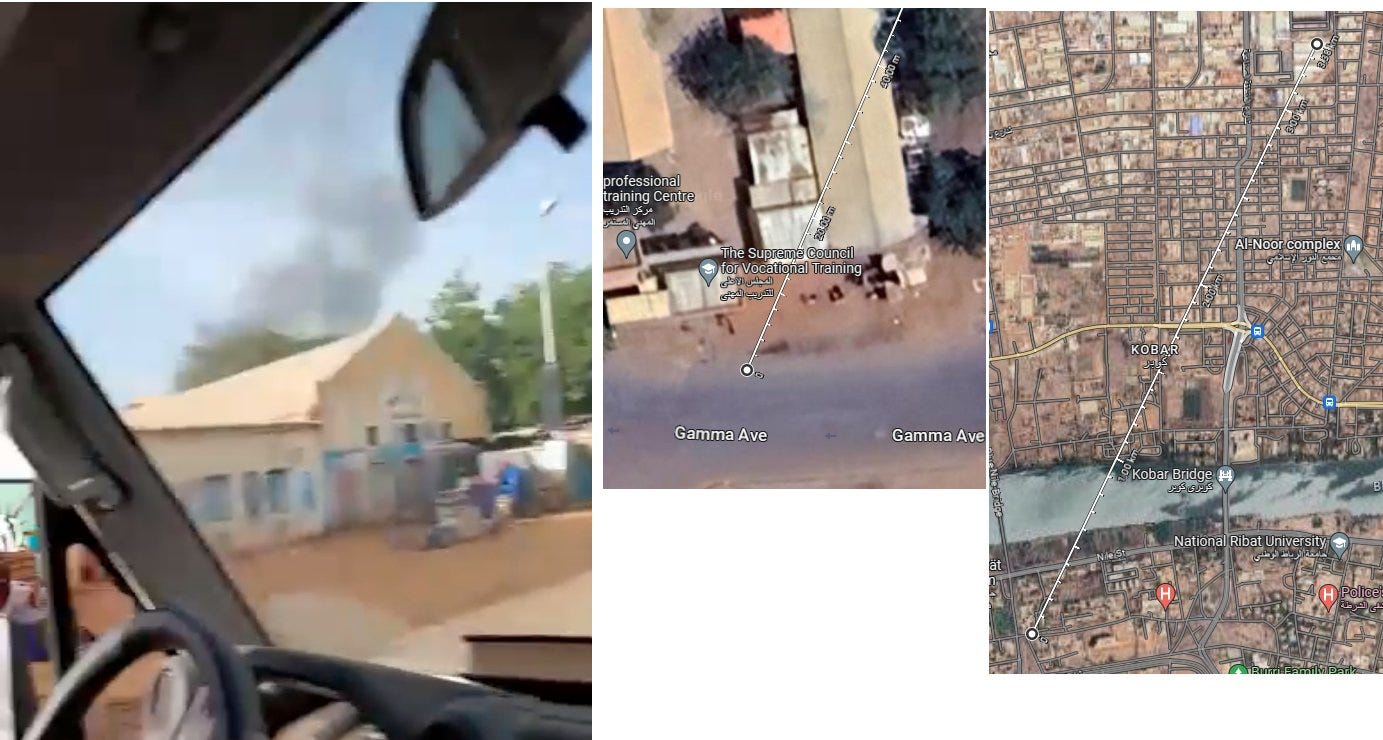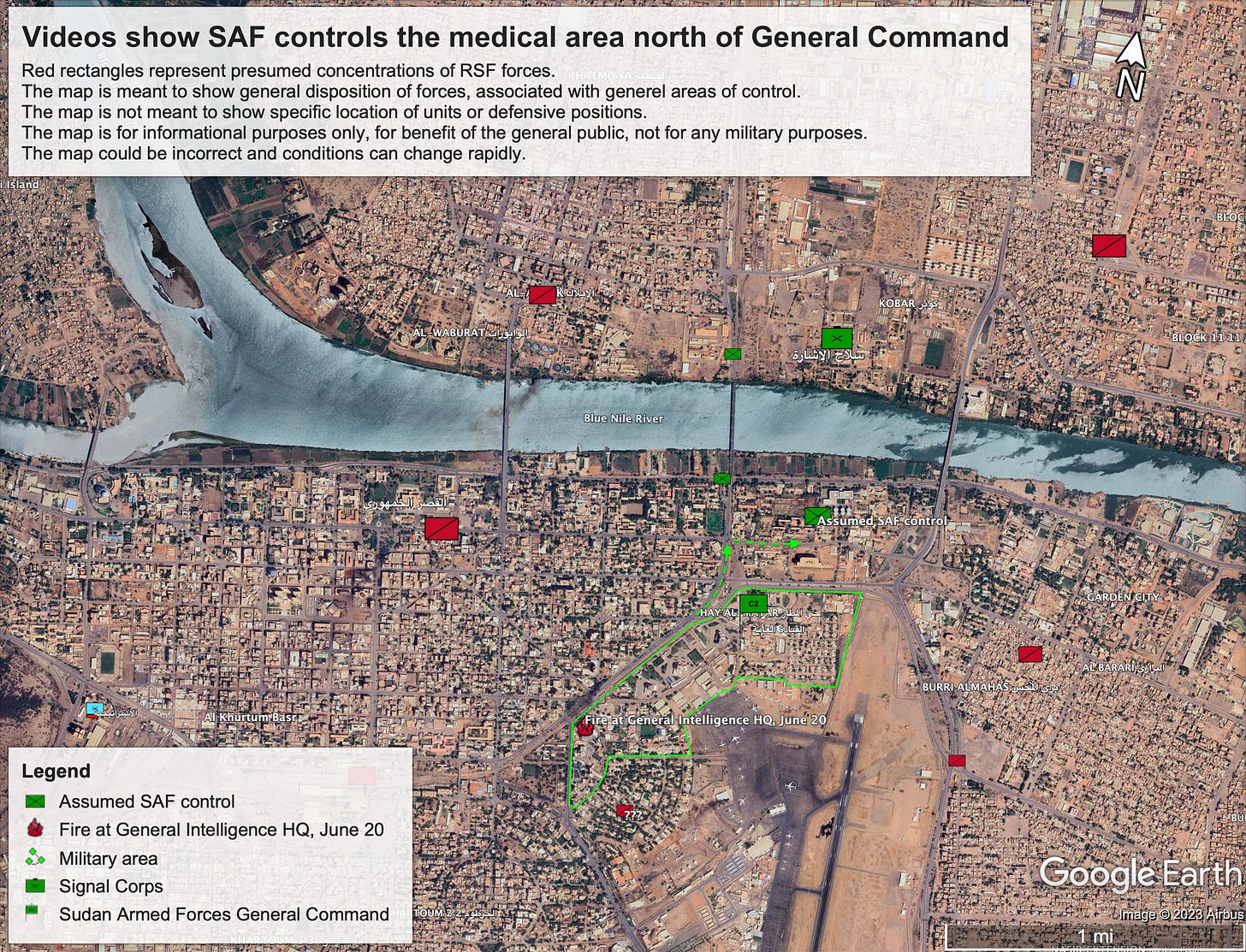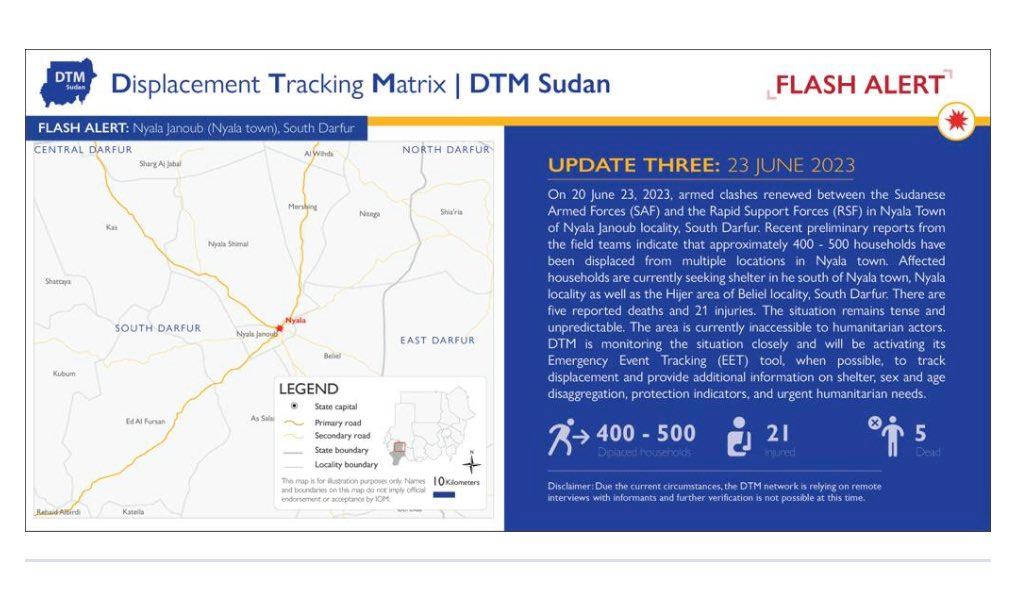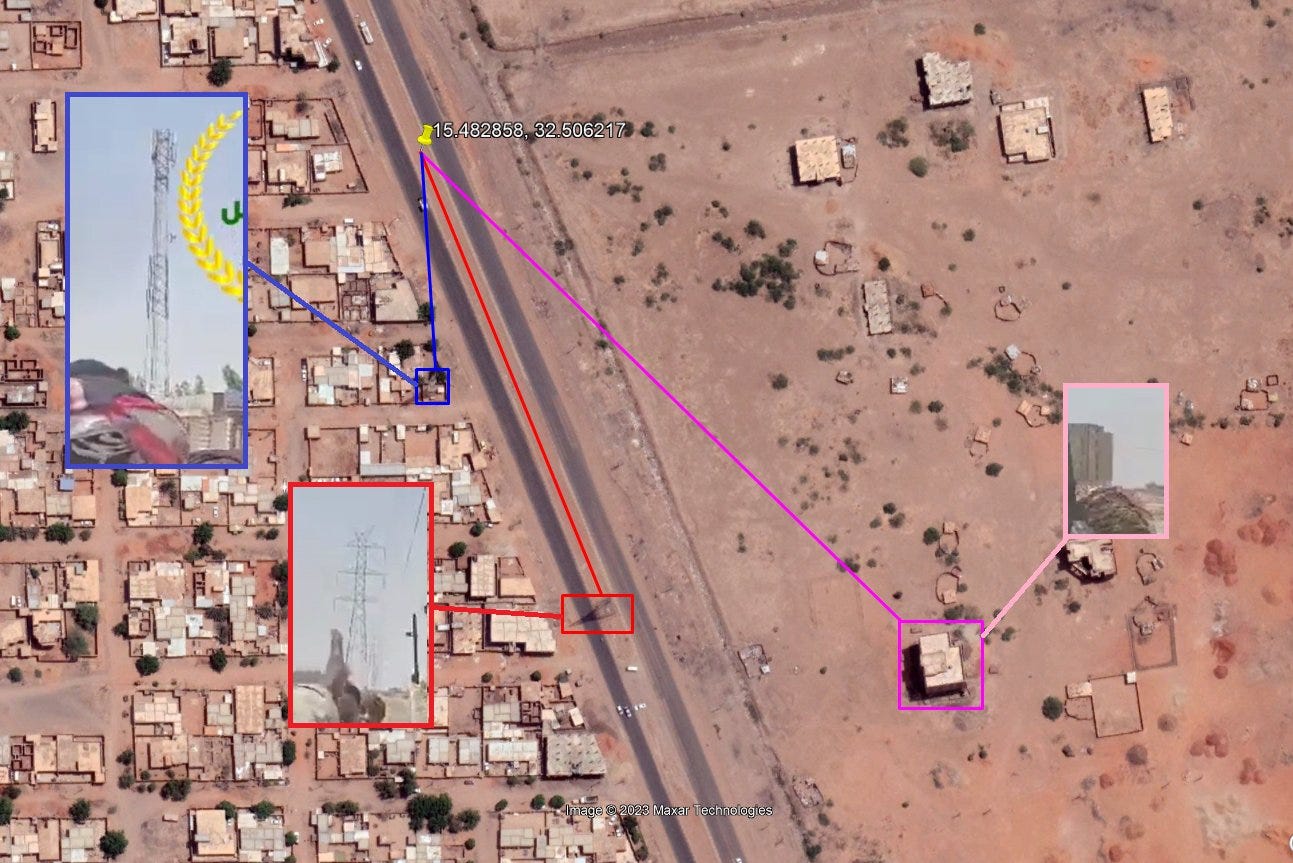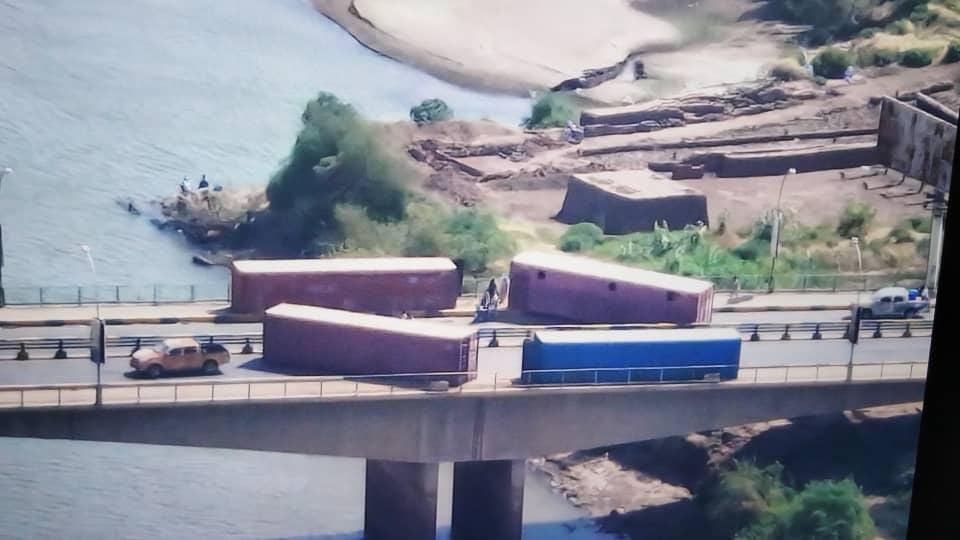Omdurman mosque and homes damaged; rocket strikes across the Nile
Geolocated videos and updates from Khartoum, Darfur, and Kordofan
Today’s update is a roundup of reports and findings from Khartoum, Darfur, and Kordofan, rather than a report on single topic. Additionally, at the end of this post there is an update on the Sudan War Monitor project itself.
Damage to Mosque
A mosque and several houses were damaged in Dar as-Salam block 38 in Omdurman, according to a video posted Thursday, June 22. According to the man who filmed the video, the buildings were damaged by government warplanes. However, the damage could also have been caused by ground-based projectiles.
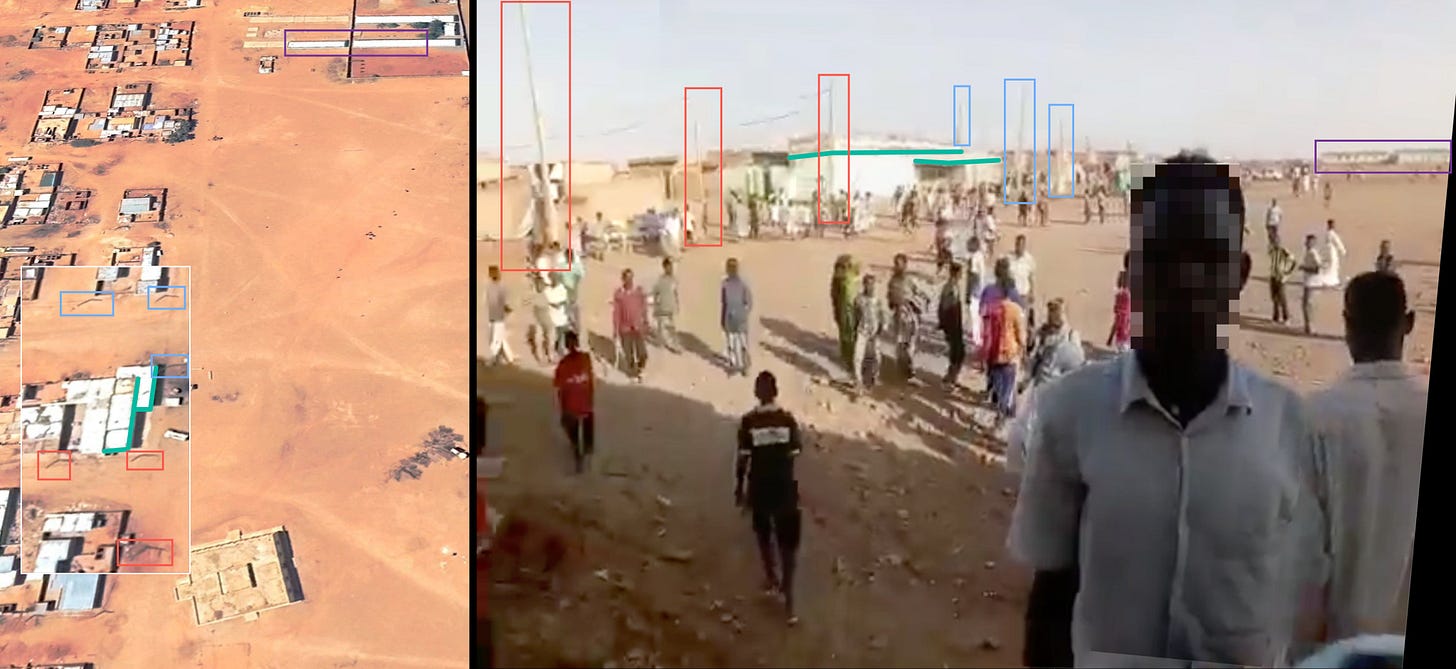
Rocket attacks on Halfaya Farms
SAF has carried out rocket strikes across the Nile from Omdurman toward Khartoum Bahri. This is a video of a SAF-operated improvised technical carrying out an attack:
The weapon is an 80mm B-8M1 rocket pod from a MiG-29 fighter aircraft, mounted on a pickup truck, according to weapons researcher @war_noir. It uses S-8 unguided rockets. The caption of the above video states that it destroyed three RSF vehicles carrying anti-aircraft guns in the Halfaya farms area. Although the video isn’t yet precisely geolocated, this type of artillery is very rare and previously was seen in use by the 9th Airborne Division, which controls North Omdurman.
Here is one such video, which is at least ten days old:
SAF have at least two of these vehicles, but probably not many more than that. One of the technicals is nicknamed “Abu Kalam 2,” according to markings on the vehicle seen in a previously circulated video.
Possibly related, there are videos of dead civilians in Halfaya Farms area in late May.
Geolocation of videos near General Command
A pair of new videos provide evidence that the Sudan Armed Forces still control the "medical city" area north of General Command.
The first video shows SAF soldier driving a pickup truck from near the entrance of General Command into the nearby medical district. Note the smoke plume, which aligns with the location of a large fire in Khartoum Bahri Industrial area June 21.
This second video shows the same army pickup truck returning from Medical City toward General Command. Slightly west of here, Khartoum University could be on the frontline between SAF and the Rapid Support Forces, or near it.
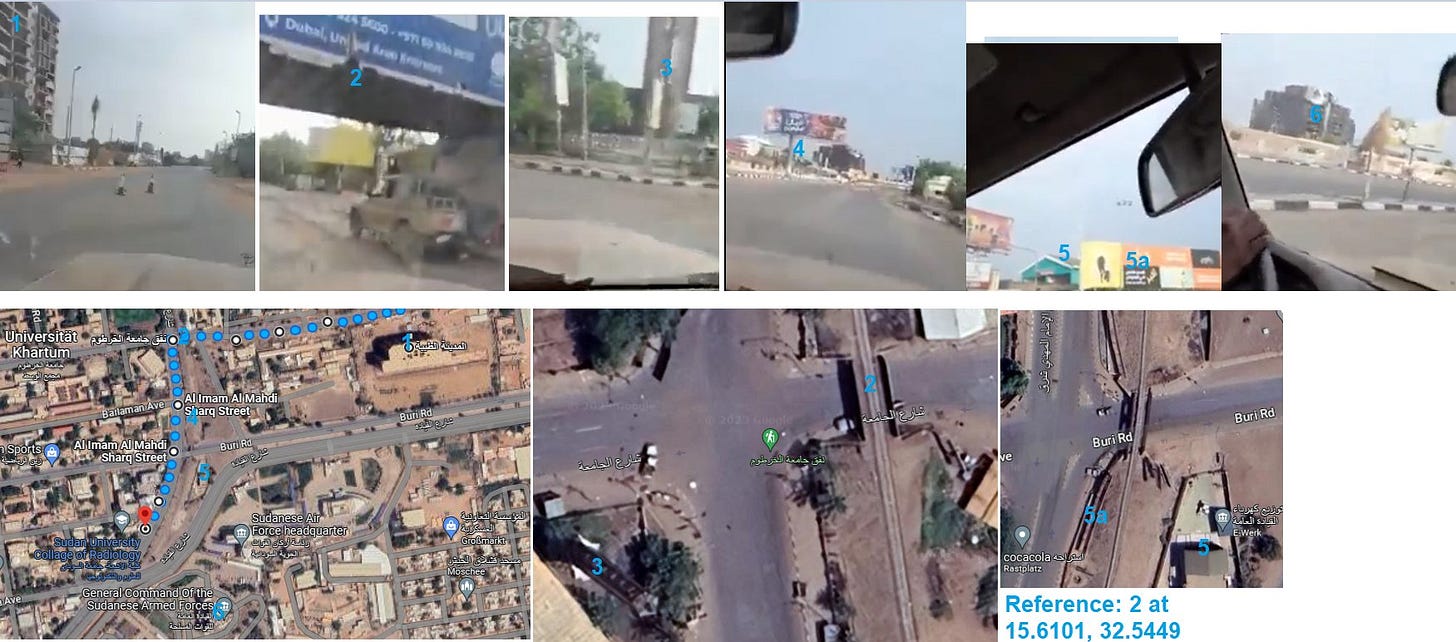
Below, this map gives a wider view of the situation around General Command. The green dotted line indicates the route taken by the vehicle in the first video above. Note that the markers indicate general force disposition, not specific location of units.
Although these videos are a few days old, there have not been reports of significant fighting in the area since then, which means the force dispositions shown in the map above likely are still approximately correct.
Fighting in South Kordofan
There has been fighting between SAF and RSF and between SAF and SPLM-N (Al-Hilu) in South Kordofan. SPLM-N is exploiting SAF’s weakness to take territory. Several media have reported on this fighting:
Dabanga: Battles persist over key areas in Sudan’s South Kordofan
Reuters: South Kordofan residents flee as new front in Sudan war develops
Bloomberg: Sudan’s Civil Conflict Spreads South as Peace Talks Falter
The SPLM-N rebels in the Nuba Mountains of South Kordofan have long-standing historic enmity with SAF. Their attacks are not necessarily coordinated with RSF. No matter what happens in the war between SAF and RSF, the SPLM-N (Al-Hilu) likely will not fight outside South Kordofan.
Fighting in El Obeid, North Kodrofan
Reuters reported Friday that there were clashes between RSF and the Central Reserve Police in El Obeid. Other sources reported several civilian casualties.
Fighting in Nyala and Al Fasher
Sporadic fighting has taken place in both Nyala and Al Fasher, despite both having previously enjoyed long periods of calm.
Reuters reported, “In Al Fashir, capital of North Darfur state, a fragile truce fell apart as the two forces clashed in residential areas.” However, Al Fasher reportedly was calmer Friday than on previous days.
Seven wounded people were brought to the hospital in Al Fasher on Thursday, including two belonging to Juba signatory groups, according to local journalist Mubarak Abusan. One citizen died after arrival at the hospital.
Since April, the MSF-supported hospital in Al Fasher has carried out over 600 surgeries for war wounded people or women requiring emergency obstetric care, according to a statement by MSF on Friday.
In Nyala, fighting began early in the morning Friday in the Al-Wadi neighborhood and Al Shabbei market, according to journalist Gouja Ahmed. There were civilian casualties. He also reported looting by militias at that market on Thursday and the killing and wounding of merchants and civilians.
Nyala has experienced power outages and telecom outages.
According to the International Organization for Migration, 400-500 households were displaced due to fighting June 20, though that number has probably grown.
RSF presence in Kalakla
A source reported Friday that the RSF “took control over Al Kalakla,” a neighborhood of southwest Khartoum. The source has family in the area and previously provided reliable information. “My family was kicked out of our house today by the RSF and fled to Madani,” the source said.
Corroborating this, a known RSF spokesperson recorded a video in Kalakla on Thursday, June 22. Standing on Kalakla Ring Road, the spokesperson pointed toward the headquarters of the Central Reserve Police to the south, saying that their war was not against the Central Reserve Police, but the latter had chosen to enter the war of their own accord so they would be attacked “without mercy.”
As mentioned in a previous analysis, RSF attacked the Central Reserve headquarters south of Kalakla on Wednesday, June 21. The attacks on the base aim to harass the Central Reserve and deter them from reinforcing SAF forces farther to the north.
Kalakla is a large area, so these two data points don’t necessarily confirm RSF control over the entire neighborhood. Both Kalakla and Abu Adam are situated between the Central Reserve base and Armored Corps, which means both those neighborhoods could become battlegrounds in the weeks ahead as SAF seeks to maintain a supply line to Armored Corps. The source in Kalakla also said that RSF cleared the police station in Abu Adam and the police ran away.
Shambat Bridge
RSF posted this video to Facebook on Friday morning, showing one of their vehicles driving across Shambat Bridge.
The video demonstrates that the bridge wasn’t fully closed off when RSF placed containers on the bridge in late May. However, the heavy vehicle seen parked between the two containers would enable them to close the bridge. It could be used to move the containers, and that truck itself could be parked in the roadway to obstruct traffic.
RSF cannot afford to lose Shambat Bridge because it is the only bridge they fully control connecting Khartoum and Bahri with Omdurman. There would be heavy fighting in the neighborhoods around the bridge if SAF made an attempt to capture it.
Project Updates
Sudan War Monitor is an initiative of Sudanese and international journalists and various technical specialists, including video analysts and geolocation specialists. Discussions are ongoing to advance the initiative.
Our email list and social media following have grown substantially. From a mass media perspective, however, the reach is still not large enough to justify the effort required in producing the content. Of course, the initiative has just begun, and the impact of media initiatives must always be judged qualitatively too.
Additional translators and writers have agreed to join the team, so that soon we will be able to provide more updates in both English and Arabic. Updates will be disseminated via email (Substack), Twitter, and an Arabic Facebook page.
Total project funding remains 0 as we have not yet sought any funding. Everybody so far is still working on a voluntary basis.
New volunteers and specialists continue to join the open-source analysis efforts, not necessarily directly in support of Sudan War Monitor but as part of the broader information ecosystem. There is a need for more weapons specialists, geolocators, and disinformation specialists. We could also use help with art and infographics.
Sudan War Monitor is provided as a public benefit. The purpose of the initiative is to help civilians better understand the conflict events and conflict dynamics.




